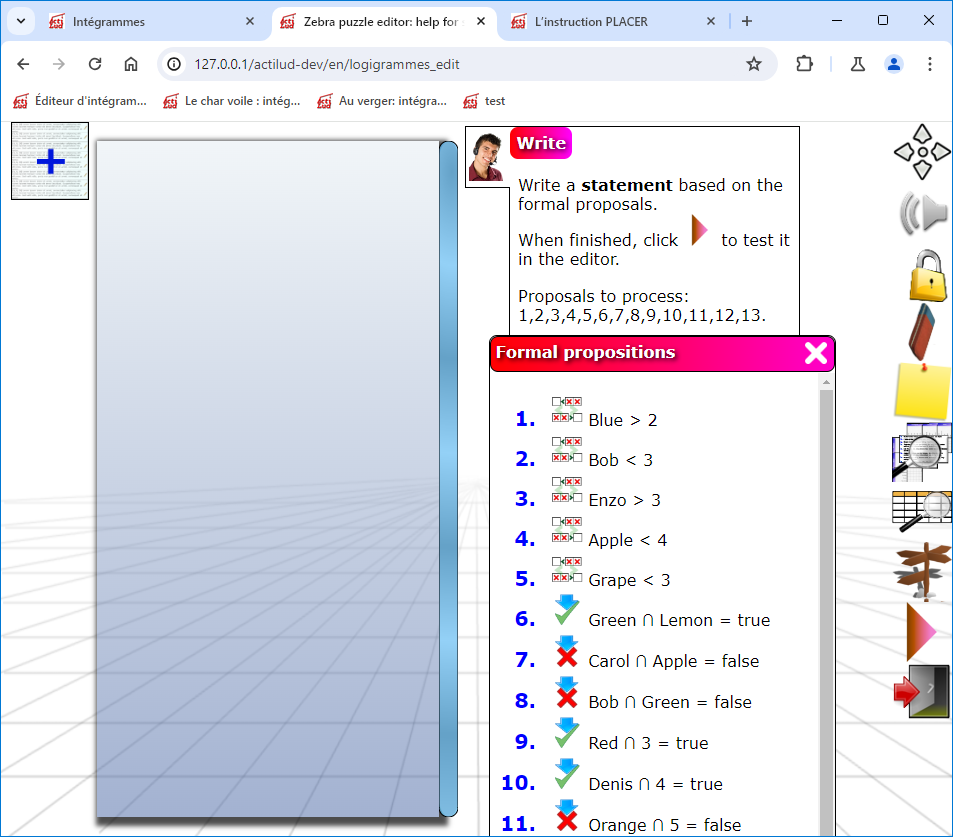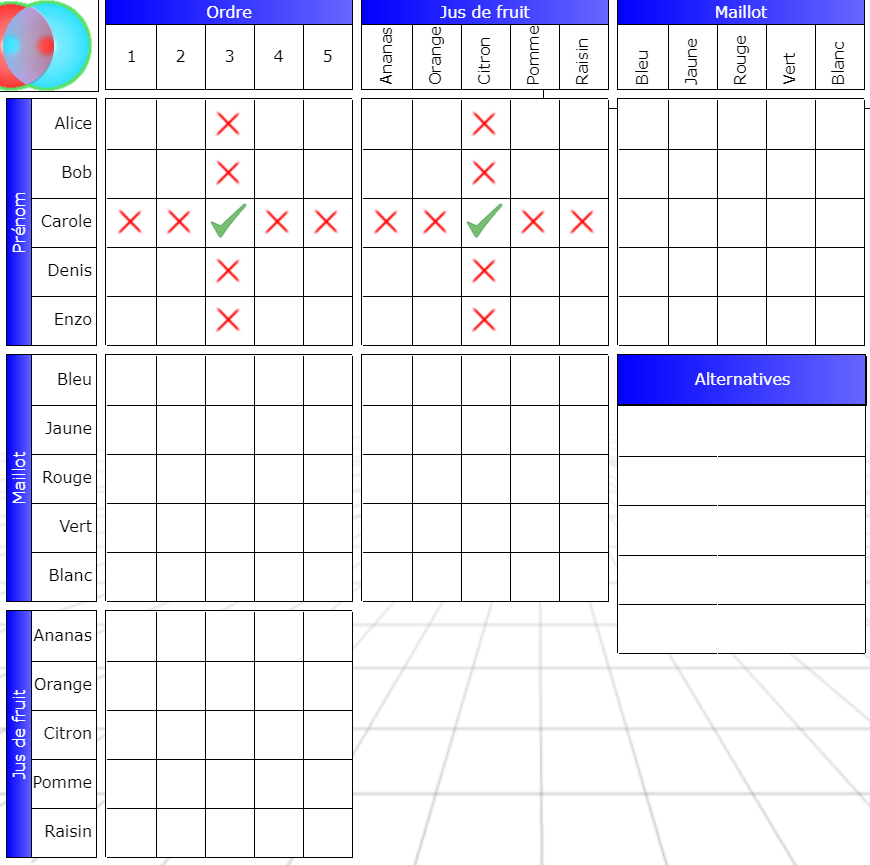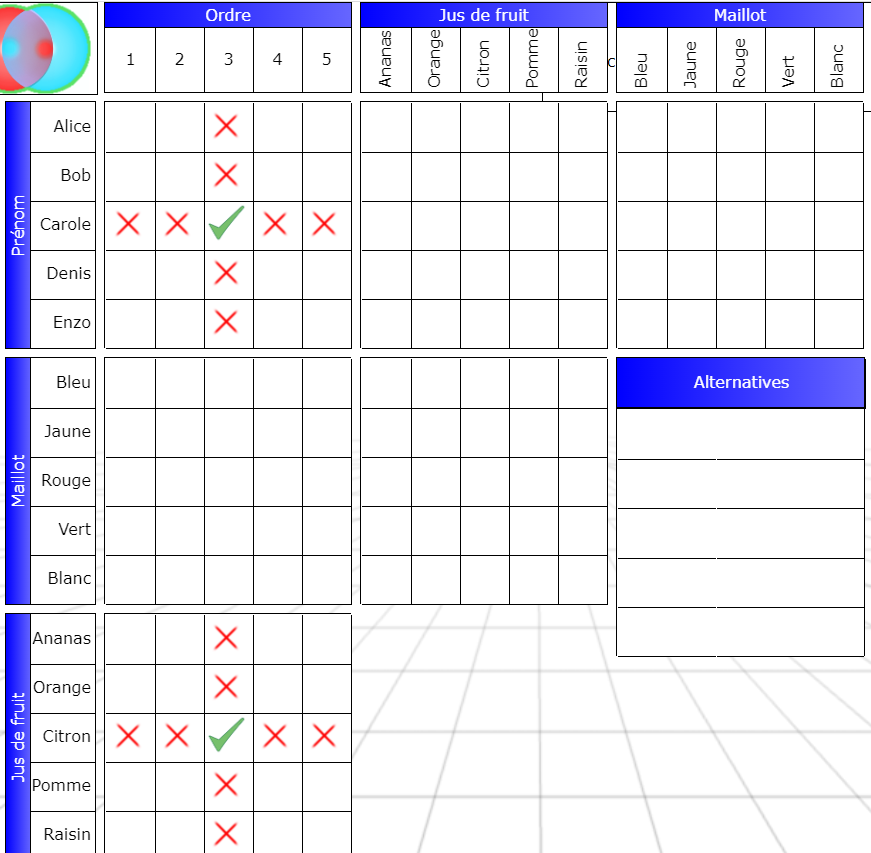C- WRITE
And here comes the fun part! It’s about transforming the formal instructions obtained in the previous step into a clear text that everyone can understand.
![]() It is accessed through the menu, write.
It is accessed through the menu, write.
Access is only possible if a list of formal proposals has been generated in the previous step.

The selector consists of a single icon: the + sign.
The collector is the large white rectangle immediately next to it. This is where we’ll place our own statements. As before, you can move a statement. To delete a statement, drag it into the selector.
To get an empty statement, you have to use the selector as usual, so drag and drop .
The statement is, again, in the form of a rectangle. You can edit it by clicking on the button:![]()
Editing takes place in the advisor. Two fields are available:
- numbers: indicate the numbers of the formal clauses referred to. The numbers must be separated by commas. They will be used by autocompletion – the ability to automatically fill in a grid from the statement.
- statement: the statement to be written
We therefore note that a statement can group together several formal propositions.
Here are some examples of translations of some formal propositions taken one by one.
Alice > 2
Alice comes after second place.Red < 4
The person wearing a red jersey arrives before the fourth.Grape >2
The person who drinks grape juice comes after second place.Lemon ∩ 3 = true
The person who drinks lemon juice is third.
Grouping formal proposals
It is possible and even recommended.
Let us take for example the following two propositions
15: Enzo ∩ green = true
19: Enzo ∩ lemon = false
These two formal propositions can be combined to give the following statement:
Enzo, who is wearing a green jersey, does not drink lemon juice.
In the numbers section we therefore indicate the numbers of the two formal propositions concerned, separated by commas: 15,19
But be careful! There are traps.
The trap of inferences
Let’s look at those instructions :
6 – Lemon ∩ 3 = true
7 – Carole ∩ 3 = true
The lemon juice lover is third. Carole is third. So Carole drinks lemon juice. This is perfectly logical. But be careful: this does not appear in formal propositions.
A sentence like:
Carole is third and drinks lemon juice
which one would tend to write, translates as this, in the first draft:

While the solver will display this:

It’s very different! Even if, in the end, it actually comes down to the same thing.
So this is how the two propositions should be translated:
The person who is third drinks lemon juice and is called Carole.
This time we are respecting the formal propositions to the letter.
To achieve this, there is a fairly simple rule to follow:
the common point between propositions ∩ becomes the subject of our statement.
Try with these two following analogous formal propositions:
8: Green ∩ Apple = true
9: Bob ∩ Green = true
Did you find it?
The solution is: The person wearing the green jersey drinks apple juice and is called Bob.
Less cumbersome formulation: The green jersey, Bob, drinks apple juice.
Here we discover the full value of integrams when it comes to writing sentences that are both concise and elegant. It is an exercise that is not so simple; but on the other hand it is very easy for a student to correct, because the objective is targeted and it does not get lost in the meanders of a plethora of written production.
Groupings galore
Let us group together those propositions :
2: Red < 4
13: White ∩ 4 = false.
The instructions are different here; so there is no need to consider the value 4 as a subject.
This gives:
The red jersey came before the fourth, who does not wear a white jersey.
And here’s a little relative clause. The art of doing grammar with logic. If I still want to put the 4 as the subject:
The fourth, who does not wear a white jersey, arrived after the red jersey.
Let’s group two other propositions :
1: Alice > 2
12: Alice ∩ 5 = false
Alice , who arrived after the second competitor, is not fifth.
And what’s next?
For now, you can only create your own custom riddles and store them on your computer. I’m looking into publishing them on the site for those who want to. Perhaps in the future. Wait and see…
